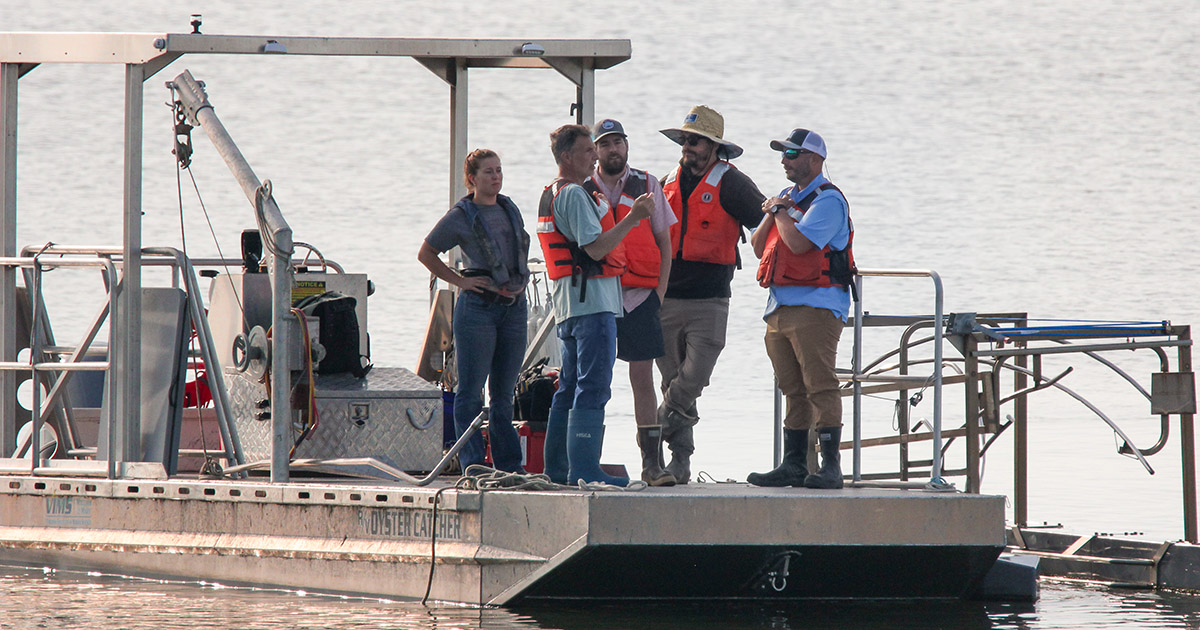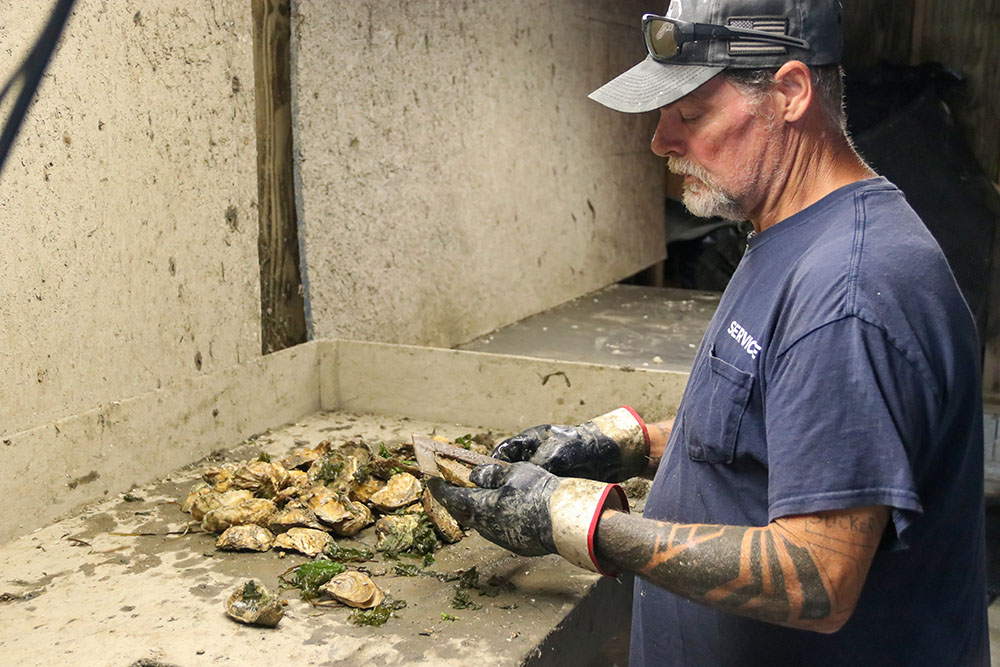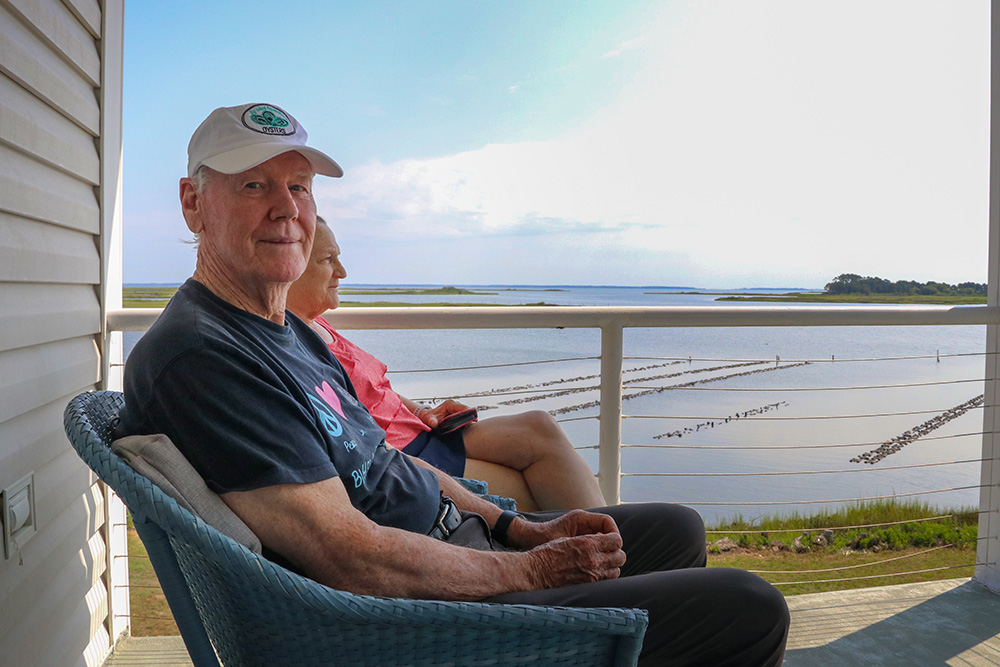Adding up the pieces to solve SUMS
 “In 2015 during our first harvest, we lost several hundred thousand oysters overnight,” said Bruce Vogt of Big Island Aquaculture in Hayes, VA. “That was the worst loss we’ve experienced. However, we are seeing increasing mortality rates each year and now account for a 50% loss of harvest in our business plan.”
“In 2015 during our first harvest, we lost several hundred thousand oysters overnight,” said Bruce Vogt of Big Island Aquaculture in Hayes, VA. “That was the worst loss we’ve experienced. However, we are seeing increasing mortality rates each year and now account for a 50% loss of harvest in our business plan.”
The cause of the large mortality event Vogt experienced with his first harvest is unknown, however, he knows that he is not alone. Dubbed sudden unusual mortality syndrome (SUMS), these mass die-offs have been plaguing oyster farms across the eastern U.S. and Gulf of Mexico since 2012.
This week, scientists at William & Mary’s Virginia Institute of Marine Science (VIMS) published a report from a two-day workshop on SUMS that brought together 28 oyster aquaculture experts from eight universities. The workshop, convened at VIMS in early2024, attempted to characterize the state of the science on the syndrome, identify urgent questions and prioritize research to understand the causes of mortality and develop mitigation strategies.
“These are devastating losses. It’s hard to write a business plan that is resilient to losing 70-80% of your crop” said Bill Walton, Acuff Professor of Marine Science at VIMS. Walton joined VIMS in 2021 and is the coordinator of the Shellfish Aquaculture program. “We wanted to shift from being reactive to proactive, so the goal of the workshop was to bring together a lot of really smart people and put all of our ideas on the table so that we can make measurable progress.”
The cause of SUMS remains a mystery. The mortality events occur primarily during the spring and early summer, but it can also affect oysters outside of this period. SUMS typically impacts domesticated oysters in their second and final season of intensive culture, yet there is evidence that even oysters traditionally planted on reefs may be affected.
“SUMS doesn’t appear to be caused by parasitic or infectious agents, though some theorize they could be one of several contributing factors,” said VIMS Professor Ryan Carnegie. “Similar mortality events have been observed in Pacific oysters, with some evidence of bacterial involvement. Right now, we don’t have conclusive evidence one way or another.”
Carnegie specializes in oyster pathogens. His lab provides pathology services free of charge to oyster farmers who experience unusual die offs and maintains a database of the events for future research. He stresses the importance of looking at all potential factors before jumping to conclusions about a single cause. “Oysters are under enormous pressure in farming environments. We need to continue looking at the conditions under which affected oysters are experiencing the greatest mortality,” said Carnegie. “This is why it’s critical that we maintain close communication with our industry partners to know where and when these events are happening and provide farmers the information and tools they need to monitor and assess their growing conditions.”
“Oysters are under enormous pressure in farming environments. We need to continue looking at the conditions under which affected oysters are experiencing the greatest mortality,” said Carnegie. “This is why it’s critical that we maintain close communication with our industry partners to know where and when these events are happening and provide farmers the information and tools they need to monitor and assess their growing conditions.”
Vogt tried to have his oysters tested after his major loss. However, the meat disappeared so quickly that there wasn’t anything to test by the time he could collect samples for the lab.
Coming together to protect an entire industry and way of life
Scanning the horizon from the dock on Vogt’s home farm, you can see Big Island, Mobjack Bay, Chesapeake Bay and, on a clear night, the Chesapeake Bay Bridge Tunnel connecting Virginia to its Eastern Shore. The area is steeped in history, revered by watermen for centuries due to the unique taste of the oysters growing in water with just the right salinity. Vogt and his wife have lived there for four decades, raising their three sons and becoming part of the local fishing industry.
“I think there can be a perception that there is a lot of money in the shellfish industry, but the margins
 are not super high. I love the business—it’s a huge boon to our coastal communities—but it’s really a labor of love,” said Walton. “So, it’s tough when a farmer calls and tells us about all the blood, sweat, tears and money they’ve invested in a crop and most of it is dead. We want to be able tell them how to prevent that from happening again.”
are not super high. I love the business—it’s a huge boon to our coastal communities—but it’s really a labor of love,” said Walton. “So, it’s tough when a farmer calls and tells us about all the blood, sweat, tears and money they’ve invested in a crop and most of it is dead. We want to be able tell them how to prevent that from happening again.”In his daily operations and at industry conferences, Vogt hears from other farmers who are experiencing similar mortality rates. “I don’t want to be negative, but I am realistic. It would be hard to continue operating if the losses keep increasing. So, I want to do whatever I can to support the scientists trying to solve this,” he said.
The VIMS report detailed presentations given by workshop participants, including perspectives on pathology, genetics, physiology and environmental factors. Also discussed were the potential roles of environmental stressors, microbial pathogens, genetic factors and husbandry practices.
From these perspectives, several research priorities were outlined. The group agreed their next steps should be collating data on the extent and frequency of SUMS events, conducting genetic analysis of survivors, evaluating the success of seed distribution and exploring nutritional contributions to stress and mortality. They also proposed small-scale experiments designed to expose oyster seed to environmental stressors in hopes of increasing adult resiliency.
Recognizing the need for collaboration between industry and the research community, communication and the development of a collaborative network became a major focus.
“We have to be realistic, but our ultimate goal is to reduce the frequency and magnitude of these events for the industry,” said Walton. “We need science-based mitigation strategies, and it’s going to take working together to gather the evidence we need to figure out what’s going on.”
Some progress has already been made, and Walton encourages those in the industry to reach out if they would like to become involved in future efforts.
Recently, members of the group secured grant funding that will allow them to conduct experiments with farmers in Texas and Virginia to compare the success of triploid oysters against diploid oysters under commercial conditions while tracking environmental factors. Diploid oysters are similar to wild oysters in that they have two chromosomes and are able to reproduce. Triploid oysters are bred to have three chromosomes and are thus asexual, allowing them to direct energy to growth rather than the development of reproductive organs. Triploid oysters are preferred for commercial farming, and some have theorized they may be more susceptible to SUMS than their diploid counterparts. These experiments will help answer that question.
Another pending grant proposal is connected to the creation of an emergency response network. This would involve industry partners providing weekly updates on their crops that will allow the researchers to better track the events and, hopefully, discern any commonalities or patterns for further investigation.
So far this year, reports of SUMS have been minimal. However, it’s early in the season and there is a concern that things may change as temperatures increase and oysters mature.
“I think our efforts have helped crystallize how we approach the problem,” said Walton. “Working together, I’m hopeful we can start teasing out the correlations to identify the underlying factors.”
